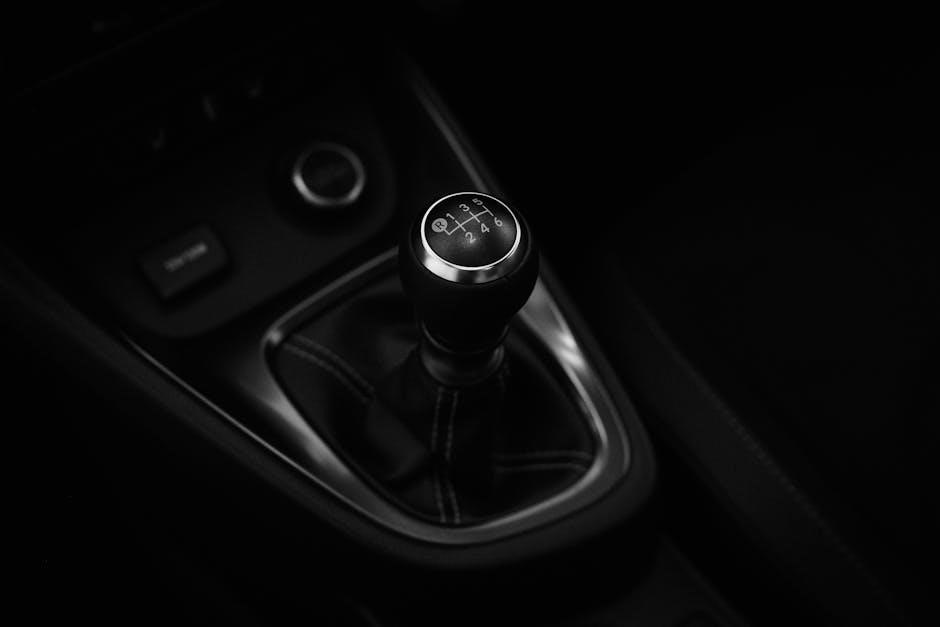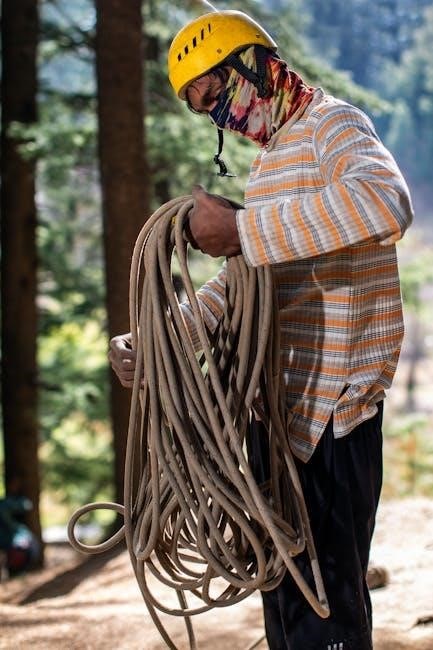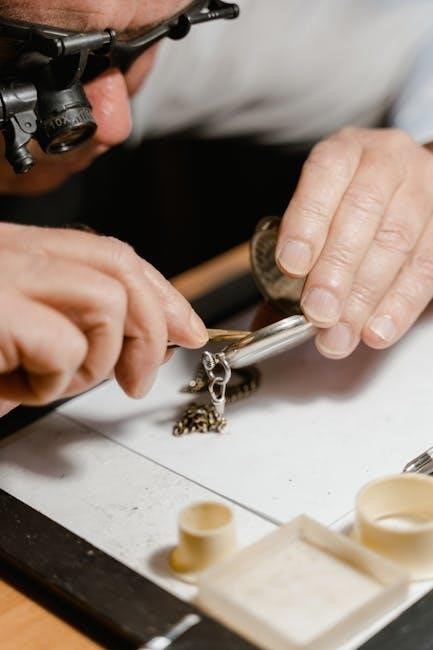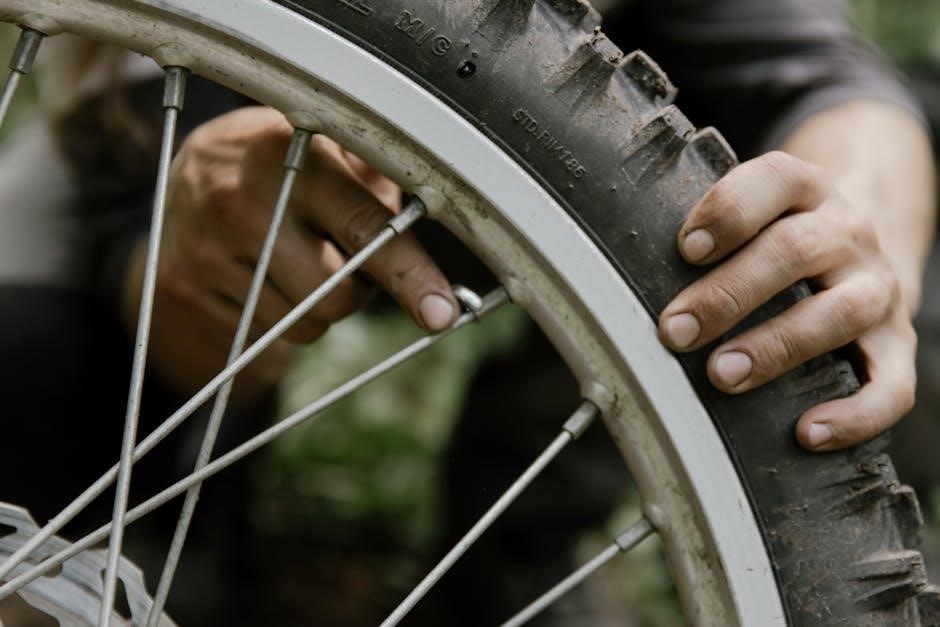
manual transmission slips out of gear

Manual Transmission Slips Out of Gear: A Comprehensive Guide
Manual transmissions slipping out of gear can stem from worn gears, damaged shift forks, or clutch issues. Low transmission fluid or a faulty pilot bearing may also cause unexpected disengagement, leading to sudden gear shifts and potential engine damage if left unaddressed.
Manual transmissions are complex systems that can develop issues over time, often leading to gears slipping out unexpectedly. This problem can stem from worn components, low fluid levels, or clutch malfunctions. Understanding the root causes is crucial for effective troubleshooting and repair. This guide provides an in-depth look at common issues, symptoms, and solutions to help drivers address slipping gears and maintain smooth transmission performance. Early detection and repair are essential to prevent further damage and ensure safe vehicle operation.

Common Causes of Manual Transmission Slipping
Manual transmission slipping is often caused by worn gears, damaged shift forks, or a failing clutch. Low transmission fluid levels and a bad pilot bearing can also contribute to this issue, leading to unexpected gear disengagement and operational difficulties.
Worn-Out Gears and Synchronizers
Worn gears and synchronizers are a primary cause of manual transmission slipping. Over time, the teeth on gears can wear down, reducing their ability to engage properly. Similarly, synchronizers, which ensure smooth gear transitions, can degrade, leading to difficulty in shifting and unexpected disengagement. This wear can result in gears popping out during operation, especially when driving in heavy traffic or uphill, and may require costly repairs if not addressed promptly.
Damage to Shift Forks and Interlock Components
Damage to shift forks and interlock components can cause manual transmissions to slip out of gear. Shift forks, responsible for engaging gears, can bend or break, preventing proper gear alignment. Interlock components, which ensure only one gear engages at a time, can wear out, allowing gears to clash or disengage unexpectedly. This damage often results from aggressive shifting or high-stress driving conditions, leading to costly repairs if not addressed quickly.
Clutch Failure to Engage or Disengage Properly
Clutch failure to engage or disengage properly can cause a manual transmission to slip out of gear. If the clutch doesn’t fully disconnect, gears may grind or fail to shift smoothly. Conversely, if it doesn’t engage properly, the engine may lose connection with the transmission. This issue often stems from worn clutch plates, misaligned components, or low brake fluid levels. Addressing these problems promptly is crucial to prevent further damage to the transmission system and ensure smooth operation.
Low Transmission Fluid Levels
Low transmission fluid levels can lead to manual transmission slipping out of gear. Insufficient fluid reduces hydraulic pressure, preventing gears from engaging properly. This causes difficulty in shifting and unexpected disengagement. Regular fluid checks are essential to maintain system performance. If levels are low, refill with the recommended fluid type to ensure smooth gear operation and prevent potential damage to internal components. Neglecting this can result in costly repairs down the line.
Bad Pilot Bearing or Bearing Wear
A worn-out pilot bearing can cause the manual transmission to slip out of gear unexpectedly. The pilot bearing supports the input shaft, and its failure allows excessive play, disrupting smooth gear engagement. This often occurs during acceleration or deceleration, leading to unpredictable shifting. A damaged bearing can also produce grinding noises and make shifting difficult. Replacing the pilot bearing is essential to restore proper transmission function and prevent further mechanical damage to the gearbox.

Symptoms of a Faulty Manual Transmission
Gears slipping out unexpectedly, difficulty engaging gears smoothly, unusual grinding or clunking noises during shifting, and vibrations during operation signal a faulty manual transmission.
Gears Popping Out Unexpectedly
Gears popping out unexpectedly is a common symptom of a faulty manual transmission. This issue often arises from worn synchronizers, damaged shift forks, or a broken selector spring. When these components fail, the gear disengages unintentionally, causing the transmission to slip into neutral or another gear. This can occur during acceleration or deceleration, posing a safety risk. If left unaddressed, it may lead to further damage, such as gear tooth wear or complete transmission failure, requiring costly repairs.
Difficulty Shifting Gears
Difficulty shifting gears in a manual transmission often indicates underlying issues such as worn-out synchronizers, damaged shift forks, or low transmission fluid levels. This can result in a stiff or unresponsive gearshift, making it hard to engage or disengage gears smoothly. If left unchecked, this problem may escalate, causing increased wear on transmission components and potentially leading to complete gear engagement failure. Regular maintenance, such as checking fluid levels and inspecting gear components, can help prevent such issues from arising.
Unusual Noises During Gear Shifting
Unusual noises during gear shifting, such as grinding, clunking, or whining, often indicate worn or damaged transmission components. These sounds may result from worn-out synchronizers, damaged shift forks, or improperly aligned gears. Such noises can signal impending issues, as they may lead to gears slipping out of place or failing to engage properly. Addressing these noises promptly is crucial to prevent further damage and ensure smooth gear transitions. Regular inspections can help identify and resolve these problems before they escalate.

Diagnosing the Issue
Diagnosing involves visual inspections, driving tests to identify slipping patterns, and using diagnostic tools for clutch and gear analysis to pinpoint the root cause effectively.
Visual Inspection of Transmission Components
A thorough visual inspection is crucial to identify worn or damaged parts. Check gears for teeth wear, synchronizers for damage, and the clutch for proper engagement. Inspect the pilot bearing for excessive play and ensure the shift linkage is aligned and undamaged. Look for signs of fluid leaks or contamination, as low fluid levels can contribute to slipping. This step helps pinpoint issues like worn-out components or misaligned parts before further diagnostics.
Driving Tests to Identify Slipping Patterns
Conduct a driving test to observe slipping patterns. Accelerate gradually to feel if the transmission slips out of gear. Check for unusual noises or vibrations during shifts. Test in various conditions, including uphill climbs and deceleration. Note the specific gears where slipping occurs. This helps determine if the issue is consistent or situational, guiding further diagnostic steps and repairs. Documenting these observations aids in pinpointing the root cause effectively.
Using Diagnostic Tools for Clutch and Gear Analysis
Employ diagnostic tools like scan tools and pressure testers to analyze clutch and gear performance. Scan tools can detect solenoid malfunctions, while pressure testers assess hydraulic system integrity. Endoscopic inspections help visualize internal components for wear or damage. These tools provide precise data, aiding in identifying clutch slippage, worn synchronizers, or low fluid pressure. Regular use of diagnostic equipment ensures early detection of issues, preventing further damage and costly repairs down the line.

Solutions and Repairs
Address slipping by replacing worn gears, synchronizers, or shift forks. Adjust or replace the clutch system and ensure proper transmission fluid levels. Diagnostic tools help pinpoint issues, enabling targeted repairs to restore smooth gear engagement and prevent further damage.
Adjusting or Replacing the Clutch System
Clutch issues often cause manual transmissions to slip out of gear. If the clutch fails to engage or disengage properly, it can lead to unexpected shifting. Adjusting the clutch pedal’s free play or replacing worn clutch plates and pressure plates is essential. Ensure the clutch master and slave cylinders are functioning correctly and refill hydraulic fluid as needed. A properly functioning clutch system ensures smooth gear transitions and prevents slippage during driving.

Replacing Worn-Out Gears and Synchronizers
Worn-out gears and synchronizers are common causes of manual transmission slipping. Over time, the teeth on gears and synchronizer rings can wear down, preventing proper engagement. This leads to gears slipping out unexpectedly. Replacing these components ensures proper gear engagement and smooth shifting; During replacement, inspect related parts like shift forks and interlocks for damage. Proper installation by a qualified technician is crucial to restore transmission performance and prevent further issues.
Refilling or Replacing Transmission Fluid
Low transmission fluid levels or degraded fluid can cause gears to slip out of place. Transmission fluid provides hydraulic pressure for smooth shifting. If levels drop, gears may struggle to engage, leading to slippage. Regularly check fluid levels and top up as needed. If the fluid is contaminated or old, replace it with the recommended type. Proper fluid maintenance ensures consistent gear engagement and prevents overheating. Avoid driving with insufficient fluid to avoid further damage to transmission components.
Repairing or Replacing Shift Linkage Components
Shift linkage components, such as shift forks and rods, play a critical role in gear engagement. Misalignment or wear in these parts can cause gears to slip out unexpectedly. Inspect for bent or damaged components and replace them if necessary. Tightening loose connections may resolve minor issues, but severe wear often requires professional replacement. Proper alignment ensures smooth shifting, preventing further damage to the transmission system.


Preventive Maintenance Tips
Regular fluid checks and clutch inspections prevent slipping issues. Avoid aggressive shifting, as it stresses components. Proper alignment ensures smooth shifting, preventing further damage to the transmission system.
Regular Transmission Fluid Checks
Regular transmission fluid checks are crucial for maintaining smooth gear operation. Low fluid levels reduce hydraulic pressure, causing gears to slip or shift unpredictably. Always use the specified fluid type to ensure optimal performance. Over time, fluid degrades, losing its lubricating properties, which can lead to increased wear on gears and bearings. Replace the fluid as recommended by the manufacturer to prevent premature wear and slippage issues. Consistent checks help maintain transmission health and prevent costly repairs.
Inspecting Clutch and Gear Components Periodically
Regular inspections of clutch and gear components are vital to prevent manual transmission issues. Check the clutch for wear and proper engagement, as failure can cause gears to slip. Inspect gears for worn teeth and synchronizers for damage, as these can lead to unexpected disengagement. Also, examine shift forks and interlock components for alignment and damage; Early detection of worn or damaged parts ensures timely repairs, avoiding costly overhauls and maintaining smooth gear transitions. This proactive approach extends transmission lifespan and reliability.
Avoiding Aggressive Shifting Practices
Avoid sudden acceleration, hard downshifting, or riding the clutch, as these practices stress transmission components. Aggressive shifting can wear out gears, synchronizers, and the clutch, leading to slipping issues. Smooth, deliberate shifts reduce friction and extend component lifespan. Proper use of the clutch, avoiding excessive revving, and gradual acceleration help maintain transmission health. This mindful approach minimizes wear and prevents unexpected gear disengagement, ensuring a smoother driving experience and reducing the risk of costly repairs.